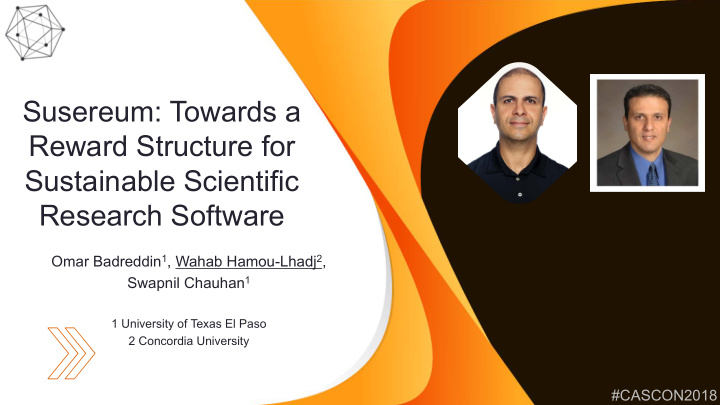



Susereum: Towards a Reward Structure for Sustainable Scientific Research Software Omar Badreddin 1 , Wahab Hamou-Lhadj 2 , Swapnil Chauhan 1 1 University of Texas El Paso 2 Concordia University #CASCON2018
Background Research has become inescapably Software-Dependent • Developers of Research Software are • – Untrained in Software Engineering – Transient Workforce – Adopt Discovery Driven Methodologies – Develop in absence of Requirements Research Projects are • – Driven by scientific contribution – Have short funding cycles 2
Academic Eco-Systems Academic careers • – Advanced by contributions of academic articles – Research software are not adequately recognized Little incentives to contribute high-quality research codes • Academic eco system are dependent on peer reviews • – Effective for static relatively short artifacts (papers) – Ineffective for large dynamic text (codes) 3
Sustainability Fundamental Challenge Software Sustainability is not unique to research software • Professional spheres systematically undermine sustainability • Prevalent practices • – Reward engineers for feature development – Sustainability is uncertain and invisible – Systematic pressures to short-term goals 4
Dev Cost: $309.5 million Cost to fix (in Year 1 only): $ 402 million Omar Badreddin
How to Address Sustainability Training and Education for Researchers and Scientists • Policies and research funding structures • Hiring professional software engineers – Understand the unique context and quality characteristics of research software. • 6 Omar Badreddin
Research Goal The goal of this research is to transform the prevalent incentive • structures in academia. We aim to establish an ecosystem that systematically promotes • contributions of scientific software. Software that is: – Sustainable over time to maximize returns – Disseminatable to other researchers for results extension – Reproducible for research results extension. – Attain broader longer-term impacts 7
Susereum Susereum = Sustainability + Ether. • Distributed Ledger • Reward contributors of research codes with immutable, • permanent, peer-recognized credit. Code Commit Quantify Scientific Award Crypto Value Peers Researcher Credit (Suse) Define & validate 8
Susereum Step One Code Change Event 9
Susereum Step Two Transaction Formation 10
Susereum Step Three Block Formation 11
Susereum Step Four Chain Formation 12
Susereum Step Five Chain Propagation to Peers 13
Susereum Step Six Peers Verify Work 14
Consensus Protocol 15
Potential Impact Open Source and Professional Spheres • Scientific and Research Software • Discovering and Sharing of Novel Sustainability Measures • Decentralized Sovereignty and Impacts Beyond Software • Sustainability – Redefine development process, artifacts formalisms, conflict resolutions for artifacts, .. – Project task priorities, schedule, task assignments, effort estimates,.. – Rewards for crowd-based software engineering 16
Open Questions To what extent do “Incentives” affect codebase quality and sustainability? • How to measure the scientific value of code contributions? • How to quantify codebase sustainability? • Analyzing large-scale research codebases • QGIS case Study – Interviewing Developers – Uncover decision making processes for individuals and teams – 17 Omar Badreddin
Summary Restructure Incentives with Crypto Credit Significant Potential Impact on Software Sustainability Decentralization of Sovereignty 18
Recommend
More recommend